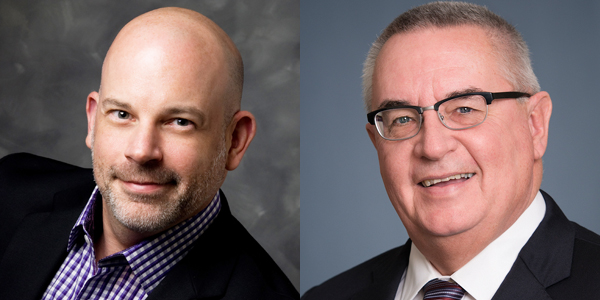Group culture is critical to making work-life fit really work
Group culture is critical to making work-life fit really work
- June 16, 2017 |
-
 LORI SHARN BRYANT
LORI SHARN BRYANT

CEOs change more than policies to encourage staff to take time off, recharge, learn

Oliver Yandle (left) and Paul Grace
Paul Grace really doesn't want anyone working overtime—or while they're on vacation either.
"My policy is at 5 o'clock we all stop working," said Grace, CEO of the National Board for Certification in Occupational Therapy. "When people go on vacation, we do not want them to do email. We want them to be on vacation."
Grace said he threatened to pull the computer plug of a senior executive who was at his desk after hours. Vacationers can relax knowing that co-workers will scan their email inboxes daily, and forward any messages that need immediate attention to an appropriate staff member.
These and other policies have helped NBCOT in Gaithersburg, Md., win recognition four years in a row as a best place to work by The NonProfit Times, based on confidential employee surveys.
Many associations offer programs and policies aimed at helping employees achieve a work-life balance or fit. But having a workplace culture that supports this fit is another matter.
Grace said colleagues have told him he's nuts to ban extra hours, but he points to a stable staff that works hard and smart to get a lot done in the allotted time.
"My whole philosophy around management is I like to treat people the way I like to be treated," Grace said. NBCOT employees "know that we have respect for what they do outside of the office."
Policies vs. reality
Culture is a very powerful factor in whether an organization truly supports a work-life fit, said Ellen Galinsky, president and founder of the Families and Work Institute, and a senior research adviser to the Society for Human Resource Management. If someone is seen as being uncommitted to the job for taking advantage of a flexible schedule, that flexibility doesn't really exist, she said.
Data drawn from the National Study of the Changing Workforce show that work-life fit is one of the strongest predictors of positive workplace outcomes. Out of seven components in the Effective Workplace Index, work-life fit ranks first or second for whether employees feel greater engagement, greater job satisfaction, and a greater probability of staying with the employer.
In fact, Galinsky said, work-life fit ranks higher than in 2008 for both greater engagement and job satisfaction. (The study—originally conducted by the Families and Work Institute—became a SHRM project in 2016.)
Galinsky said work-life fit is not a "silver bullet"without other aspects of an effective workplace, including opportunities for advancement and satisfaction with wages and benefits.
"These things go together, and together they're much more powerful than alone."
The Association of Legal Administrators is an award winner in SHRM's "When Work Works" recognition program for its flexible scheduling and time off policy.
Executive Director Oliver Yandle said the ALA work environment was more regimented when he joined the organization in 2012.
"There tended to be a premium on being at your desk in order to demonstrate that you were actually being productive," Yandle said.
Yandle said ALA realized that improving the culture would help advance strategic goals and help it compete for new talent. Based on research with the staff, ALA began implementing changes including allowing people to work remotely at least part of the time. To do this, ALA started moving more information to the cloud, and improved communication and technology platforms. Twelve people now regularly work remotely. ALA, which reported revenue of $7.5 million in 2015, has 34 full-time equivalent positions.
In January, ALA introduced unlimited time off. People can take off as much time as they want or need as long as they have their manager's approval and it doesn't disrupt getting work completed.
Yandle said some people were concerned they would be considered slackers for taking time off, so ALA made it mandatory for everyone to use at least four weeks of vacation.
One way ALA makes sure everyone has manageable workloads is through careful tracking of time spent on different projects. "If someone is working beyond an 8-hour day, we want to be sure to capture that," Yandle said.
Leading by example
Grace, CEO of the $14-million revenue NBCOT for 16 years, said it is important to set an example. Unless he is traveling, he follows the same 9 to 5 office schedule as everyone else.
Six of NBCOT's 38 employees work remotely full time, and two others with long commutes split their time between the home and office. Everyone—even new employees—has the same 22 days of personal time off plus 11 holidays each year.
He said there is a fairness component to making everyone follow the same set of rules. Less-senior staffers know managers have more flexibility to do work in other venues and at other times, while they must accomplish their work within a fixed period of time under certain conditions.
"I think that creates an unfortunate dynamic … and can definitely have an effect on how an organization functions," Grace said.
